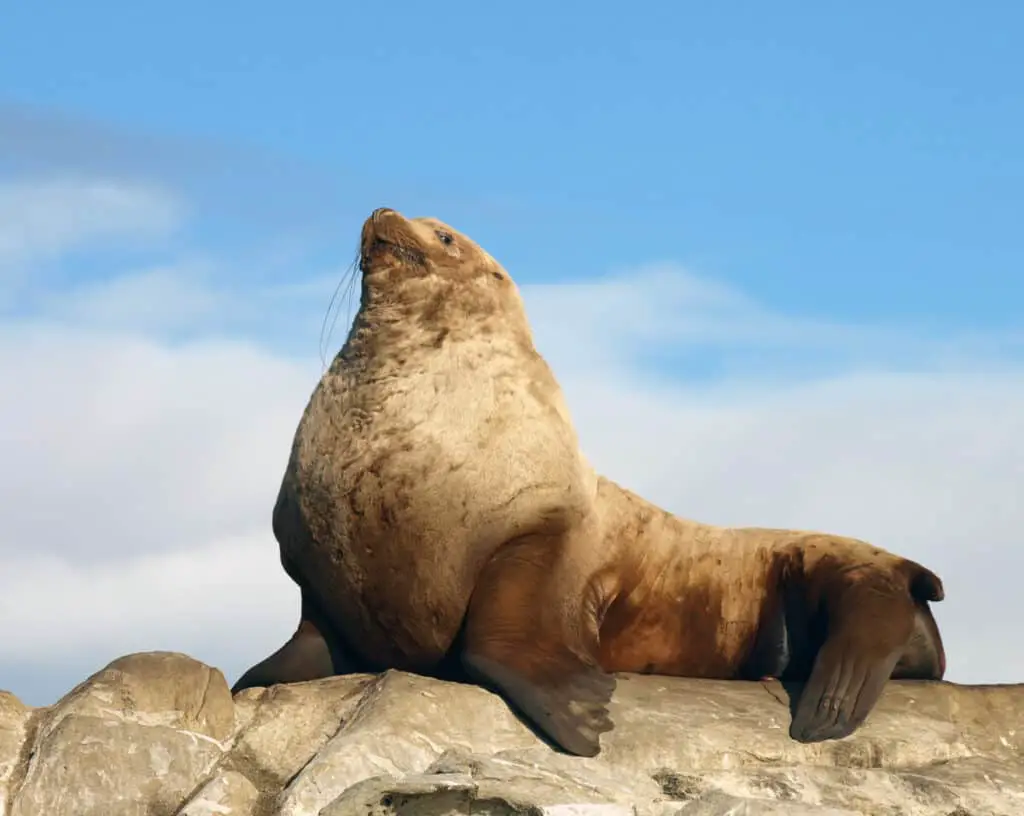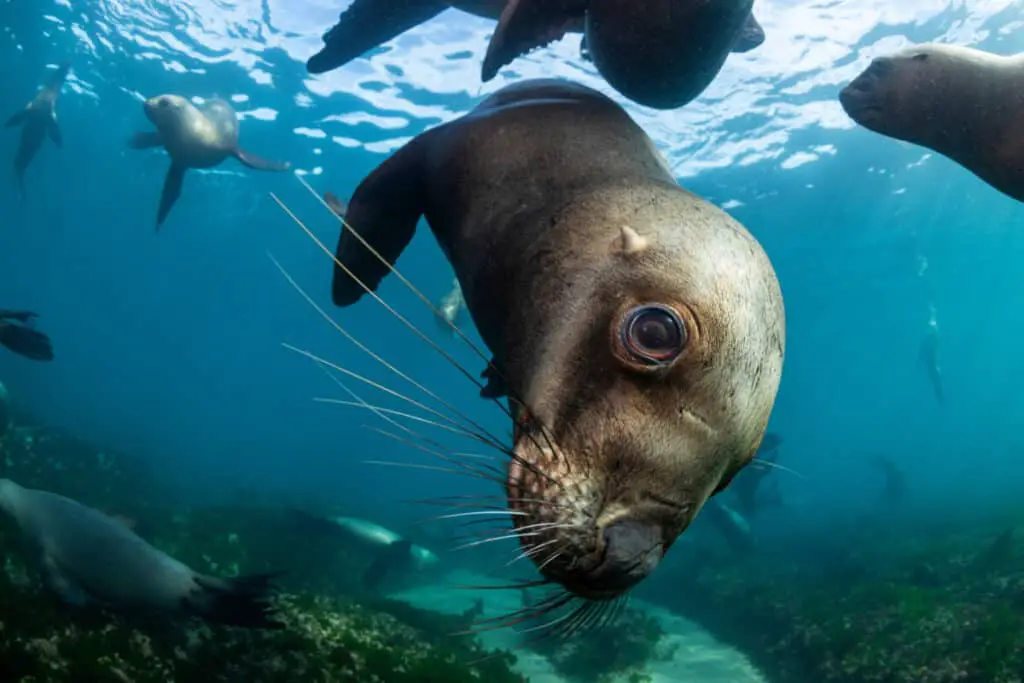Sea lions are a group of marine mammals belonging to the family Otariidae. They are characterized by their external ear flaps, which distinguish them from true seals.
Sea lions can be found in various parts of the world, including the Pacific coast of North America, South America, Australia, and some islands in the Southern Hemisphere.
These animals have a streamlined body shape that enables them to swim efficiently underwater. Their powerful front limbs are used for propulsion during swimming and maneuvering on land or ice.
Sea lions are social creatures and form large colonies where they breed, rest, and molt. Despite being protected under conservation laws in many countries, several species of sea lion face threats such as habitat loss due to human activities and incidental capture in fishing gear.
Understanding the biology and ecology of these fascinating creatures is crucial for effective management strategies aimed at conserving their populations.

Anatomy And Physical Characteristics
The sea lion is a fascinating creature that has adapted to life in the water over millions of years. Its evolutionary history dates back to the Eocene epoch, where it diverged from its land-dwelling ancestors and evolved into its current form.
The sea lion’s streamlined body shape, which can reach up to 8 feet in length and weigh up to 1 ton, allows for efficient swimming and diving at great depths. In addition to their physical adaptations, sea lions possess physiological characteristics that allow them to thrive underwater.
They have large lung capacities that enable them to hold their breath for long periods while hunting prey or escaping predators. Their thick fur keeps them insulated against cold ocean temperatures, while their webbed flippers provide excellent propulsion through the water.
These adaptations make the sea lion one of nature’s most impressive marine mammals, perfectly suited for life in the oceanic environment.
California Sea Lions: A Battle against Predators
Distribution And Habitat
The anatomy and physical characteristics of sea lions enable them to thrive in aquatic environments. Their streamlined bodies, powerful flippers, and webbed feet allow for efficient swimming and diving abilities. Additionally, they possess a thick layer of blubber that aids in insulation and buoyancy.
Moving on to distribution and habitat, sea lions are found throughout the world’s oceans, from temperate to polar regions. They typically inhabit rocky shores or offshore islands where they can haul out onto land to rest and breed. However, their specific habitats vary depending on the species of sea lion. For example, California sea lions primarily reside along the west coast of North America while New Zealand sea lions can be found around sub-Antarctic islands.
- Migration patterns:
Sea lions exhibit both seasonal and long-distance migration patterns. The timing and distance of these migrations depend on factors such as breeding cycles, food availability, and environmental conditions.
- Ecological role:
As top predators in marine ecosystems, sea lions play an important ecological role by regulating prey populations. They also serve as indicators of ecosystem health as changes in their population size or behavior can reflect larger-scale environmental shifts.
Swimming And Movement
Swimming and Movement are key aspects of the sea lion’s life. These animals have adapted to their aquatic environment through various techniques that allow them to move efficiently underwater.
One such technique is the use of their powerful flippers, which they flap in a motion similar to bird wings, propelling themselves forward. Additionally, sea lions possess streamlined bodies with elongated snouts and tapered tails that further aid in reducing drag while swimming.
When compared to other aquatic mammals like dolphins or whales, sea lions may not be as fast swimmers but have excellent maneuverability due to their strong limbs. They can also hold their breath for up to 20 minutes while diving deep into the ocean in search of prey.
Furthermore, these marine creatures have developed adaptations for efficient movement in water, such as a thick layer of blubber that provides insulation from cold temperatures and buoyancy control when diving.
Overall, Swimming and Movement are essential skills for the survival of sea lions. Their unique physical characteristics and adaptation make them well-suited for an aquatic lifestyle. Understanding these traits can help researchers gain insight into how organisms adapt to different environments over time without interfering with natural habitats’ ecosystems.
Steller Sea Lions’ Predators Exposed: Unveiling the Threats
Social Behavior And Communication
Vocalizations are an essential tool in sea lion social behavior and communication. These marine mammals have an impressive array of vocalizations that they use to communicate with each other, including barks, growls, roars, grunts, and moans. They also use body language such as head movements or postures to convey their messages effectively.
Vocalizations can communicate a variety of things from aggression to submission and playfulness. Group dynamics among sea lions are complex and fascinating. Most species form colonies where males establish territories within the group for mating purposes. Females tend to be more social than males and often gather together while nursing their young ones.
Social hierarchies exist among both sexes but are more pronounced among males who compete fiercely for access to females during breeding season. Sea lions also engage in various types of behaviors like playing or swimming together which strengthens social bonds between individuals.
Sea lion’s communicative abilities through vocalization forms a crucial aspect of its social behavior pattern. The knowledge around these facets highlights unique insights into how animals interact with one another in the wilds’ natural settings. Furthermore, understanding the intricacies behind group dynamics provides us with clues on effective ways to protect this endangered animal population by safeguarding critical habitats or mitigating human activities detrimental to them without interfering with their natural way of life.
Threats And Conservation Status
While sea lions display an impressive range of social behaviors and communication, their existence is threatened by various factors.
Overfishing practices have had a significant impact on the food sources available to these animals. The decline in fish populations has resulted in malnourished sea lions that are more susceptible to disease and death. This situation exacerbates when human disturbance disrupts their natural habitats.
Human activities such as tourism, oil exploration, and fishing negatively affect the well-being of sea lion colonies. Tourist boats can cause extreme noise pollution which could lead to hearing loss for these creatures. Oil spills destroy marine ecosystems leading to starvation among sea lion populations while also compromising breeding sites. Fishing nets entangle them causing injuries or even death; this practice further reduces food availability since it traps non-target species like herring, anchovies, and squid, which are important food sources for sea lions.
Additionally, waste products from human settlements pollute water bodies where they live hence increasing vulnerability to diseases caused by toxic substances.
A concerted effort must be made towards conservation efforts if we hope to preserve these magnificent creatures for future generations to admire and appreciate.
Importance Of Research And Conservation Efforts
To successfully undertake research and conservation efforts for sea lions, researchers utilize various methods to gather data that will enable them to gain insight into the animal’s behavior and ecology.
One of these methods involves tracking the movements of individual sea lions using satellite tags or radio transmitters attached to their bodies. This allows scientists to collect information on migration patterns, feeding habits, and habitat use through remote monitoring.
Another common method used in research is direct observation where scientists observe sea lion behavior without disturbing the animals’ natural environment. They may also capture individuals for medical checks or measurements before releasing them back into the wild. These techniques provide valuable data on population dynamics, reproduction rates, and overall health status critical for effective management decisions.
Public Awareness
As researchers continue to conduct studies aimed at understanding different aspects of sea lion biology and ecology, public awareness plays a crucial role in promoting conservation efforts.
Through education campaigns targeting communities living near sea lion habitats and tourists visiting breeding sites, people can learn about threats facing these marine mammals such as habitat loss, pollution, and overfishing.
By raising awareness among local residents and visitors alike on how human activities impact sea lions’ habitats negatively, it becomes possible to foster behavioral change that supports sustainable practices that ensure long-term survival of this species.
Public involvement in conservation initiatives provides an opportunity for everyone who cares about preserving our planet’s biodiversity to contribute towards protecting endangered species like the sea lion.

Conclusion
Sea lions are fascinating creatures with unique anatomical and physical characteristics. These pinnipeds have streamlined bodies that allow them to swim effortlessly through the water, aided by their powerful flippers and torpedo-shaped form. They also possess excellent eyesight and hearing, which is essential for hunting prey in their oceanic habitats.
These animals can be found in various locations around the world, from rocky coasts to sandy beaches. Although they primarily hunt fish, they are known to consume other marine life as well. Their social behaviors involve complex communication patterns that include vocalizations and body language.
Despite being charismatic and beloved by many, sea lions face numerous threats such as overfishing, habitat loss due to human activities, pollution, and climate change. As a result of these issues, many species of sea lions are considered vulnerable or endangered.
It is crucial that we continue research efforts aimed at understanding these animals’ biology and behavior while working towards conservation measures that will help ensure their survival in the future.
In conclusion, sea lions play an important role in our oceans’ ecosystems and provide valuable insight into marine life’s complexities. However, it is clear that urgent action must be taken to protect them from ongoing threats posed by human activity. By increasing awareness about their plight and supporting conservation efforts designed to preserve these magnificent creatures for generations to come, we can make a significant difference in securing a better future for both sea lions and ourselves alike.

